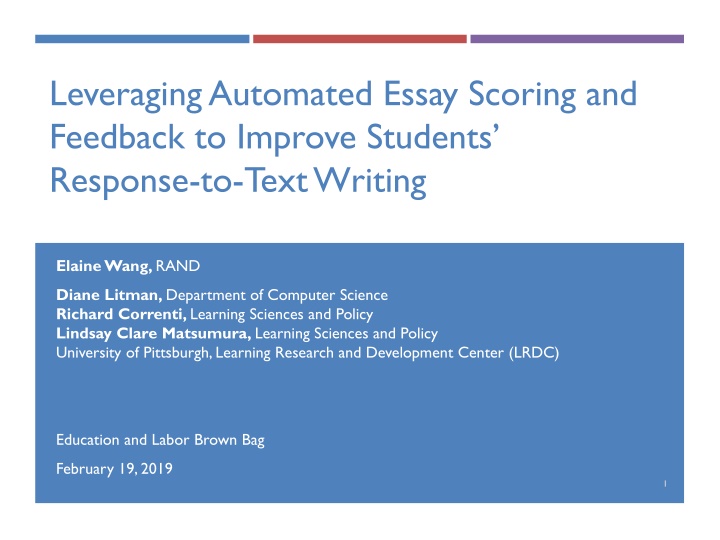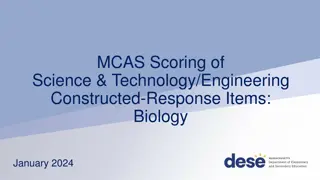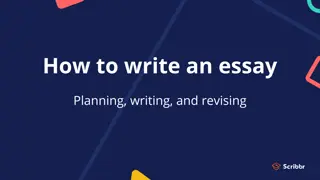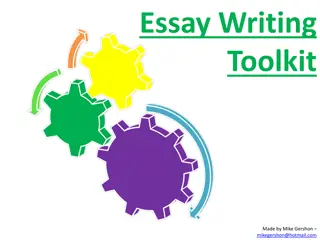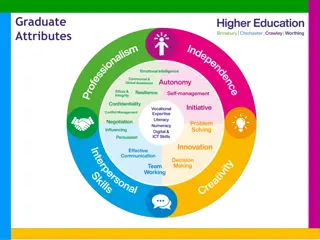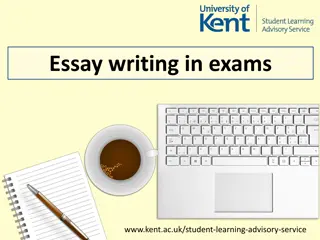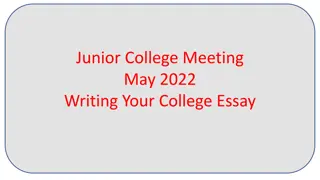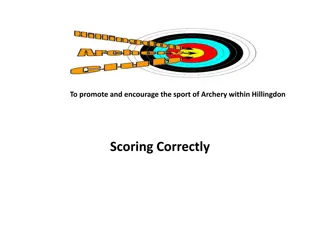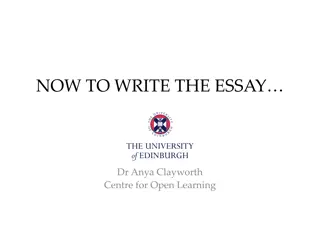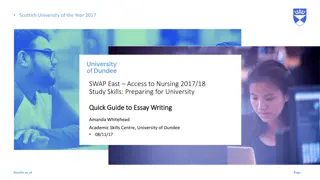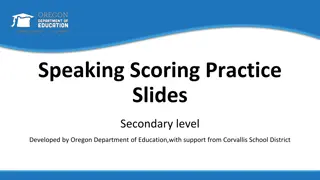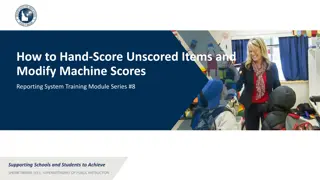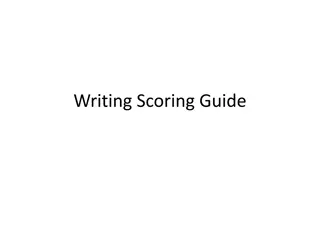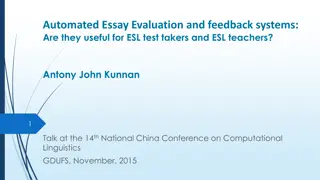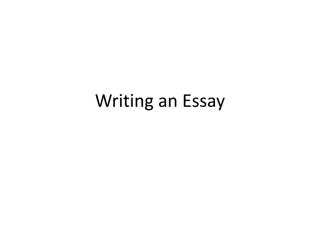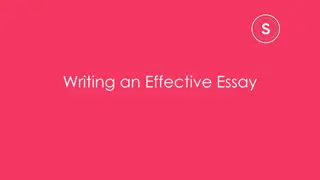Leveraging Automated Essay Scoring for Student Writing Enhancement
This study explores the use of Automated Essay Scoring and Feedback to enhance students' response-to-text writing skills. The research team presents findings on developing tools for assessing and improving students' text-based writing abilities, aiming to support teachers in instructing these skills effectively.
Download Presentation

Please find below an Image/Link to download the presentation.
The content on the website is provided AS IS for your information and personal use only. It may not be sold, licensed, or shared on other websites without obtaining consent from the author.If you encounter any issues during the download, it is possible that the publisher has removed the file from their server.
You are allowed to download the files provided on this website for personal or commercial use, subject to the condition that they are used lawfully. All files are the property of their respective owners.
The content on the website is provided AS IS for your information and personal use only. It may not be sold, licensed, or shared on other websites without obtaining consent from the author.
E N D
Presentation Transcript
Leveraging Automated Essay Scoring and Feedback to Improve Students Response-to-Text Writing Elaine Wang, RAND Diane Litman, Department of Computer Science Richard Correnti, Learning Sciences and Policy Lindsay Clare Matsumura, Learning Sciences and Policy University of Pittsburgh, Learning Research and Development Center (LRDC) Education and Labor Brown Bag February 19, 2019 1
Full Project Team PIs (University of Pittsburgh, Learning Research and Development Center) Diane Litman, Computer Science & Intelligent Systems Richard (Rip) Correnti, Learning Sciences & Policy Lindsay Clare Matsumura, Learning Sciences & Policy Subcontractor Elaine Wang, RAND Graduate Students (University of Pittsburgh) Emily Howe, Learning Sciences & Policy Ahmed Magooda, Computer Science Rafael Quintana, Learning Sciences & Policy Zahra Rahimi, Intelligent Systems Colin Zhang, Computer Science Study Coordinator Lisa Correnti, Learning Research and Development Center 2
Outline of Presentation Motivation for present research Response-Text-Assessment (RTA) Our prior work: Automated essay scoring (AES) of RTA Our current work: eRevise: Automated feedback system for RTA 3
Studying response-to-text writing instruction at-scale and supporting students acquisition of this skill requires development of new tools Recent ambitious reform in literacy standards (e.g., CCSS, 2010) emphasize having students support claims with appropriate text evidence, but students struggle with this, and teachers struggle to teach the skill Research on practices that support development of these skills is necessary However, lack of quality assessments to assess students text-based writing skills is a barrier to conducting such research Furthermore, a reliable and valid method for scoring such assessments at- scale is needed Features of the automated essay scoring (AES) system can be leveraged into formative feedback system to inform teachers instruction and students response-to-text writing improvement 4
RTA Writing Prompt The author provided one specific example of how the quality of life can be improved by the Millennium Villages Project in Sauri, Kenya. Based on the article, did the author convince you that winning the fight against poverty is achievable in our lifetime ? Explain why or why not with 3-4 examples from the text to support your answer. 7 Correnti, R., Matsumura, L.C., Hamilton, L.S., & Wang, E. (2013). Assessing students' skills at writing in response to texts. Elementary School Journal, 114(2), 142-177.
Examples of student responses scoring low (1) on Evidence dimension Sample 1 Sample 2 Yes, because even though proverty is still going on now it does not mean that it can not be stop. Hannah thinks that proverty will end by 2015 but you never know. The world is going to increase more stores and schools. But if everyone really tries to end proverty I believe it can be done. Maybe starting with recycling and taking shorter showers, but no really short that you don't get clean. Then maybe if we make more money or earn it we can donate it to any charity in the world. Proverty is not on in Africa, it's practiclly every where! Even though Africa got better it didn't end proverty. Maybe they should make a law or something that says and declare that proverty needs to need. There's no specic date when it will end but it will. When it does I am going to be so proud, wheather I'm alive or not.
Example of student response scoring high (4) on Evidence dimension I was convinced that winning the fight of poverty is achievable in our lifetime. Many people couldn't afford medicine or bed nets to be treated for malaria. Many children had died from this dieseuse even though it could be treated easily. But now, bed nets are used in every sleeping site. And the medicine is free of charge. Another example is that the farmers' crops are dying because they could not afford the nessacary fertilizer and irrigation. But they are now, making progess. Farmers now have fertilizer and water to give to the crops. Also with seeds and the proper tools. Third, kids in Sauri were not well educated. Many families couldn't afford school. Even at school there was no lunch. Students were exhausted from each day of school. Now, school is free. Children excited to learn now can and they do have midday meals. Finally, Sauri is making great progress. If they keep it up that city will no longer be in poverty. Then the Millennium Village project can move on to help other countries in need.
Our Prior Work: Automated Essay Scoring (AES) of RTA 11
Research Questions What does an AES system used to rate the Evidence dimension of the RTA look like? What is the reliability of AES scores? What is the validity of AES scores? 12
Our AES system uses Natural Language Processing (NLP) features inspired by the rubric We developed three substantive NLP features NPE (Number of pieces of evidence): Multiple pieces of evidence drawn from different parts of the text SPC: (Specificity): Specific details for each piece of evidence are provided CON: Concentration: High concentration signals listing of evidence without elaboration/explanation of evidence and receives a low score The algorithm also considers the following non-substantive feature: Word count Rahimi, Z., Litman, D., Correnti, R., Matsumura, L.C., Wang, E. & Kisa, Z. (2014). Automatic scoring of an analytical response-to-text assessment. In S. Trausan-Matu, S., Boyer, K., Crosby, & M., Panourgia, K. (Eds.). Intelligent Tutoring Systems. Paper presented at the 12th International Conference on Intelligent Tutoring Systems (ITS), Honolulu, HI (601-610). Springer. 13
AES system was developed and tested on two corpora Corpus 1 From literacy study in single large urban district in MD n = 1,569 responses from 5th and 6th graders Human scores by expert (n=702) Double-scored by trained undergraduates (n=867) Corpus 2 From literacy study in urban districts in CA n = 2,000 assessments from 6th, 7th, and 8th graders Approximately 800 used to date Double-scored by trained undergraduates
AES scores demonstrate reliability with gold standard human scores Our rubric-based models perform as well as (if not better than) other models Kappa 0.61-0.62 compared to 0.46-0.61 Rahimi, Z., Litman, D., Correnti, R., Wang, E., & Matsumura, L.C. (2017). Assessing Students' use of evidence and organization in response-to-text writing: Using natural language processing for rubric-based automated scoring. International Journal of Artificial Intelligence in Education, 1-35. DOI 10.1007/s40593-017-0143-2
Comparison of the distribution of the AES (light green) and human (light purple) scores and their overlap (teal) for the 1,529 scored essays. 16
Validity of AES scores matter too! To build a stronger validity argument, we examined relationship of human- and AES- generated ratings with: measures of student achievement Both human scores and AES scores correlate with students scores on the state standardized test (including reading and math scale scores) measures of instructional quality AES scores are sensitive to differences in opportunities-to-learn analytic writing (OTLwrt) instruction across classrooms, but not as sensitive to differences in skills- based (i.e., basic) comprehension instruction Correnti, R., Matsumura, L.C., & Wang, E., Litman, D., Rahimi, Z., & Kisa, Z. (submitted). Automated scoring of students use of text evidence in writing. Correnti, R., Matsumura, L.C., Hamilton, L.S., & Wang, E. (2012). Combining multiple measures of students opportunities to develop analytic text-based writing. Educational Assessment, 17(2-3), 132-161.
Predictive validity of opportunities-to-learn analytic writing (OTLWRT)holds Table: Effects of OTL Analytic Writing on RTA Evidence Scores (Human versus Computer) in Multivariate Models with Simultaneous Prediction of Reading and Math State Standardized Achievement Scores Primary inference does not change RTA Evidence Scores Coefficient has a slight increase for AES scores Human AES Classroom Covariates+ Intercept, m00 0.06 0.14 -0.01 0.15 Grade, m01 -0.02 0.17 0.00 0.19 (.17-.21) Masters, m02 -0.10 0.13 0.01 0.14 Standard error has slight increase PhD, m03 -0.20 0.20 -0.13 0.23 Adv. Prof. Certification, m04 -0.09 0.11 -0.18 0.13 Curric. Coordinator, m05 0.22 0.16 0.20 0.19 (.064 .072) Class Math Prior Ach., m06 0.00 0.13 0.03 0.14 Class Reading Prior Ach., m07 -0.13 0.13 -0.09 0.14 Pct. Var. Explained Between Classrooms Virtually Unchanged Class Average Absences, m08 -0.10 0.07 0.01 0.08 Tch. Years Experience, m09 -0.02 0.06 -0.06 0.07 Number of Methods ELA Courses, m010 0.05 0.06 0.03 0.07 (33%-34%) OTLwrt, m011 0.17** 0.06 0.21*** 0.07 OTLcmp, m012 -0.06 0.06 -0.05 0.07 ~ p<.10, *p<.05, **p<.01, + Adjusting for student covariates such as gender, race, free and reduced lunch, age, number of absences, prior ach. on literary passages, prior ach. on informational passages
What distinguishes our AES system? Rates young students writing Not holistic; focuses on Evidence dimension Rubric-based, based on substantive features Specifically developed for this task RTAmvp Demonstrates predictive validity with measures of instructional quality 19
Our Current Work: eRevise: Automated Writing Evaluation (AWE) System for RTA 20
Research Questions What does an automated feedback system for students text evidence use on the RTA look like? Can such a systemhelp improve the quality of students text evidence use? 21
We developed feedback messages informed by theory of effective formative feedback Puts forth a coherent vision of an effective practice Feedback is understandable and actionable Information is specific enough to improve the piece of work Also generalizable to other contexts/similar tasks 22
We built an automated feedback system on desirable qualities of evidence use corresponding to AES features Quality Dimension AES Feature Count of number of main topics from the text addressed in student essay (NPE) Complete Each claim is supported with multiple pieces of evidence Accurate Evidence is relevant to the claim Specific Evidence points to particular incidents or information from the text Explained The connection between the claim and evidence is explicit and logical Count of the keywords associated with each main topic (SPC) Different topics in close proximity are indicative of student providing evidence in a brief list, without elaboration (CON) 23 Wang, E., Matsumura, L.C., & Correnti, R., (2018). Student writing accepted as high-quality responses to analytic text-based writing tasks. The Elementary School Journal, 118(3).
System Usage & Architecture Zhang, H., Magooda, A., Litman, D, Correnti, R., Wang, E., Matsumura, L. C., Howe, E., & Quintana, R. (2019). eRevise: Using natural language processing to provide formative feedback on students' use of text evidence in writing. In Proceedings Thirty-First Annual Conference on Innovative Applications of Artificial Intelligence. Honolulu, HI. 25
Spring 2018 Pilot Deployment of eRevise 143 students of seven 5th and 6th grade teachers in two public rural parishes in LA used eRevise eRevise helped improve students text evidence use, as evaluated using RTA rubric (1-4) Mean scores improved from first to second draft, from 2.61 to 2.78 (p = 0.001) eRevise increased the quantity and relevance/specificity of text evidence use, as evaluated using NLP features Feature values increased from first to second draft NPE: from 2.61 to 2.81 (p 0.003) SPC_TOTAL_MERGED: from 9.65-11.15 (p 0.001) 27
Most recently, we are doing a deep qualitative analysis of students responses to understand their revision behavior and improve eRevise Early results suggest a majority of students attempted to address the feedback, given via eRevise, but few essays substantively improved 77% (110/143) of students attempted to address the feedback received More students receiving a higher level of feedback attempted to address the feedback they received Of the 110 essays that attempted to address feedback 42% did not show improvement from first to second draft, in line with the feedback (i.e., did not effectively execute revisions) 36% showed slight improvement 22% substantive improvement Wang, E., Matsumura, L.C., & Correnti, R. (in preparation). eRevise: Automated formative feedback system to improve students use of text evidence in writing. 28
A number of factors may account for (lack of) attempt and improvement after revision Students who attempted to address feedback and students whose essay showed greater improvement seem to Be more motivated writers/have better attitudes toward writing than students who did not Understand the feedback they received better We also explored associations with class-level characteristics We detect a potential positive relationship between students attempt to address feedback and revision improvement with classes where the teacher requires that students revise and resubmit some essays (in response to teacher s written feedback) 29
Students attempts to add evidence resulted in several missteps Misstep Made small surface-level fixes Example This is how the author of this passage convinced me on the question didif the author convinceconvinced me or not that "winning''winning the fight against poverty is achievable in our lifetime".lifetime''. Added evidence that is not text based Malaria is a very dangerous disease that can kill anyone who catches it. People who live in Africa are petrified that they are going to get Malaria that they can not even shut their eyes to get a good night's sleep. Added details that repeat what is already in first draft Added evidence that does not add to argument (i.e., random details) Another reason is that the story said that now water is connected to the hospital so now they can have water. Also they have a generator for power so thy can now have light. Also it says that "It is that "Its hard for me to see people sick with preventable diseases,people who are near death when they shouldn't have to be. I just get scared and sad."Also, "Little kids were wrapped in cloth on their mothers backs, or running around in bare feet and tattered clothing.
Students attempts to explain their use of evidence were ineffective for several reasons Misstep Example Added a 1-2 sentence conclusion that does not connect claim and evidence Added explanation that just repeats or paraphrases evidence In conclusion, it's good that other people want to care about other people and it is wrong to just let them die. The author showed me that the poverty is important in our life. I chose these examples because they show how much progress we have made. These people have done so much against poverty I believe that "winning the fight" against poverty is achievable. All in all, I am convinced that "winning the fight" against poverty is achievable in life. I put this evidence because it is proof from the text that backs up the answer. Added explanation that focuses on choice of evidence instead of content of evidence
Based on qualitative analysis, how can we improve eRevise to promote more effective revisions? Improve feedback messages Improve interface 32
EXTRA SLIDES 33
Rubric criteria and features in the AES system correspond 34
Examples of two topics (and Associated Words) used to calculate NPE and SPC Topic Topic Words (Used to calculate NPE) care, health, hospital, treatment, doctor, electricity, disease, water, sick, medicine, generator, no, die, kid, bed, patient, clinical, officer, running Specific Phrases (Used to calculate SPC) Yala sub district hospital, no running water electricity not medicine treatment could afford no doctor only clinical officer three kids bed two adults kids not attend go school not afford school fees no midday meal lunch schools minimal supplies concentrate not energy Hospitals Schools school, supplies, fee, student, midday, meal, lunch, supply, book, paper, pencil, energy, free, children, kid, go, attend
Automating extraction of topics Goal: Reduce the amount of expert effort and improve the scalability of an AES system for Evidence dimension Results: Scoring performance using automatically extracted data-driven topical components is promising Rahimi, Z., & Litman, D. (2016). Automatically extracting topical components for a response-to-text writing assessment. Proceedings 11th Workshop on Innovative Use of NLP for Building Educational Applications.
We also developed an alternative approach that is potentially more efficient and reliable This year we developed a co-attention-based neural network for source-dependent AES Increases reliability (not sure about validity) Eliminates human source encoding and feature engineering Zhang, H., & Litman, D. (2018). Co-attention based neural network for source-dependent essay scoring. In Proceedings of the Thirteenth Workshop on Innovative Use of NLP for Building Educational Applications (pp. 399-409). 38
The system selected feedback messages based on key features to specifications determined by our analysis of student responses NPE indicates the breadth of unique topics SPC (after further processing) indicates the number of unique pieces of evidence A matrix of these two matches each essay to appropriate feedback 39
In 2018-2019 and beyond, we are expanding our study and deepening our inquiry along several lines Studying 50 teachers in Louisiana, whose classes will use eRevise with two versions of RTA Exploring impact of eRevise on teachers beliefs about response-to- text writing, criteria for evaluating student writing, feedback on student writing Teacher survey and interview pre- and post-eRevise experience, assigned tasks Improving eRevise Personalizing feedback messages Improving interface to support revisions Developing materials to guide teachers 42
